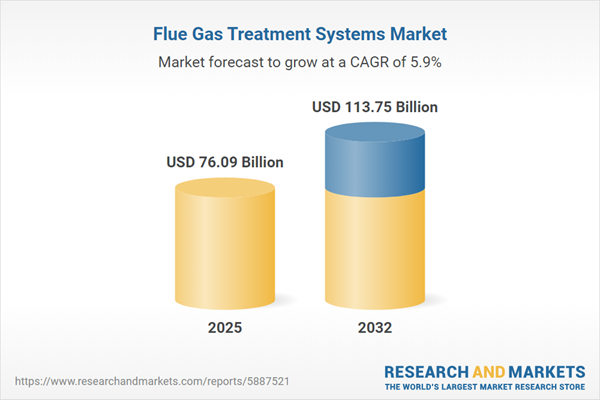Speak directly to the analyst to clarify any post sales queries you may have.
In today’s regulatory landscape, senior executives require transparent, actionable intelligence to align emissions management strategies with evolving compliance demands. The Flue Gas Treatment Systems Market continues to advance as a critical lever for operational reliability, environmental risk management, and sustainable industrial development.
Market Snapshot: Growth and Opportunity in the Flue Gas Treatment Systems Market
The Flue Gas Treatment Systems Market maintains steady momentum, with global valuations forecast to rise from USD 71.75 billion in 2024 to USD 76.09 billion in 2025, ultimately reaching USD 113.75 billion by 2032. This reflects a compound annual growth rate (CAGR) of 5.92%. Key drivers behind this expansion include stringent government regulations mandating advanced emissions control, increased capital into digital monitoring tools and infrastructure modernization, and continual innovation in flue gas mitigation technologies. Both developed and rapidly industrializing regions are intensifying their focus on these solutions to secure long-term compliance and business resilience.
Scope & Segmentation of the Flue Gas Treatment Systems Market
- Technology: Activated Carbon Injection is employed to target specific contaminants, Electrostatic Precipitators are used for efficient particulate capture, and Fabric Filter solutions come in various cleaning configurations to maximize system effectiveness. Flue Gas Desulfurization systems, available in dry, semi-dry, and wet variants, address sulfur-based emissions, while Selective Catalytic Reduction and Selective Non-Catalytic Reduction technologies support control of nitrogen oxides and sulfur oxides.
- Application: Core application areas include cement manufacturing, petrochemical processing, power generation, and steel production. Each sector faces unique emission streams and regulatory pressures, requiring customized treatment solutions to meet operating demands and compliance standards.
- End User: Key users encompass cement manufacturers, independent power producers, industrial operators, public utilities, and steel manufacturers. These organizations operate in environments with high emissions intensity and strict oversight, prioritizing robust flue gas systems to maintain business alignment with new and existing environmental frameworks.
- Sales Channel: Distribution is handled by aftermarket service providers, distributors, and original equipment manufacturers (OEMs), all of whom deliver essential system servicing, installation, and modernization support. This structure ensures integration of emerging technologies, minimizes operational disruption, and supports ongoing maintenance of installed assets.
- Regions: The market’s global reach includes the Americas, Europe, Middle East & Africa, and Asia-Pacific. Notable leadership is observed in the United States, Canada, Germany, United Kingdom, China, India, and Australia, each benefiting from robust regulatory activity and industrial diversification that drive adoption of advanced flue gas solutions.
- Leading Companies: Industry innovations are driven by companies such as Babcock & Wilcox Enterprises, Mitsubishi Hitachi Power Systems, Johnson Matthey plc, Andritz AG, FLSmidth & Co. A/S, Hamon & Cie, Thermax Limited, Doosan Lentjes GmbH, Haldor Topsoe A/S, and DuPont de Nemours, Inc. Their sector-focused expertise supports tailored compliance strategies and effective system deployment across diverse operational profiles.
Key Takeaways for Senior Decision-Makers
- Flue gas treatment is integral to corporate compliance, supporting reliable industrial functions in regulated sectors.
- Deployment of modular and automated system designs increases operational flexibility and improves response capacity to regulatory changes.
- Investments in system upgrades and digital monitoring empower companies to proactively address sustainability targets and reduce process risks.
- Robust supplier and service networks enable agile adaptation of solutions that accommodate distinct regional, sectoral, and compliance needs.
- Effective aftermarket partnerships facilitate predictive maintenance and rapid access to parts, safeguarding asset performance.
- A dynamic sales channel network fosters the adoption of turnkey solutions and expert support throughout the lifecycle of flue gas treatment assets.
Tariff Impact: Navigating Policy and Sourcing Shifts in 2025
Recent adjustments to U.S. tariff schedules on critical flue gas treatment components are prompting industry leaders to modify sourcing approaches and safeguard against input cost volatility. Manufacturers are expanding regional networks and establishing onshore alliances to lower exposure to international trade uncertainties. Utilizing flexible agreements and regional distributors also supports continued access to equipment and maintenance services, maintaining operational consistency amid ongoing supply chain adjustments.
Methodology & Data Sources
This research combines comprehensive analysis of regulatory filings, industry publications, and technical documents with insights from primary interviews with technology suppliers and compliance authorities. External validation from an independent expert panel ensures relevance and methodological integrity for strategic planning.
Why This Report Matters
- Enables effective competitive assessment, segmentation, and technology monitoring to inform procurement and capital allocation decisions.
- Offers clear frameworks that link emissions investments with operational realities and current regulations, fostering robust compliance across industrial sectors.
- Provides actionable recommendations for vendor selection and emissions management strategy development in alignment with changing standards.
Conclusion
Flue gas treatment systems are core to meeting compliance and sustainability demands. This report equips decision-makers to anticipate market changes and ensure resilient operations in a competitive and evolving landscape.
Additional Product Information:
- Purchase of this report includes 1 year online access with quarterly updates.
- This report can be updated on request. Please contact our Customer Experience team using the Ask a Question widget on our website.
Table of Contents
3. Executive Summary
4. Market Overview
7. Cumulative Impact of Artificial Intelligence 2025
Samples

LOADING...
Companies Mentioned
The key companies profiled in this Flue Gas Treatment Systems market report include:- Babcock & Wilcox Enterprises, Inc.
- Mitsubishi Hitachi Power Systems, Ltd.
- Johnson Matthey plc
- Andritz AG
- FLSmidth & Co. A/S
- Hamon & Cie, S.A.
- Thermax Limited
- Doosan Lentjes GmbH
- Haldor Topsoe A/S
- DuPont de Nemours, Inc.
Table Information
| Report Attribute | Details |
|---|---|
| No. of Pages | 195 |
| Published | October 2025 |
| Forecast Period | 2025 - 2032 |
| Estimated Market Value ( USD | $ 76.09 Billion |
| Forecasted Market Value ( USD | $ 113.75 Billion |
| Compound Annual Growth Rate | 5.9% |
| Regions Covered | Global |
| No. of Companies Mentioned | 11 |









